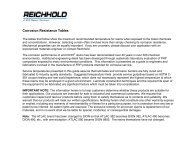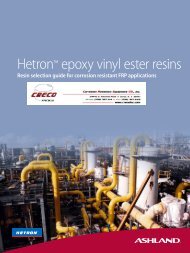Sodium Hypo FRP - CRECO, Inc.
Sodium Hypo FRP - CRECO, Inc.
Sodium Hypo FRP - CRECO, Inc.
- No tags were found...
You also want an ePaper? Increase the reach of your titles
YUMPU automatically turns print PDFs into web optimized ePapers that Google loves.
SECTION { }<br />
FIBERGLASS REINFORCED PLASTIC TANKS<br />
PART 1 - GENERAL<br />
1.1 SCOPE OF WORK<br />
A. This section covers the furnishing and installation of fiberglass reinforced plastic tanks<br />
for the storage of <strong>Sodium</strong> <strong>Hypo</strong>chlorite.<br />
Connecting piping, valves and accessories not specified herein are covered in other<br />
sections.<br />
1.2 SUBMITTALS<br />
A. Submit to the Engineer, in accordance with the submittal section, complete drawings,<br />
details, and specifications covering tanks, fittings and accessories.<br />
B. Drawing Approval<br />
1. Shop drawings shall be approved by the Engineer prior to fabrication. Approval of<br />
Drawings by the Engineer shall not release the Contractor of responsibility of<br />
compliance with this Section. All proposed changes to this Section shall be stated<br />
in writing.<br />
1.3 REFERENCE STANDARDS<br />
A. All materials and construction methods shall comply with the applicable provisions of<br />
the following standards:<br />
1. ASTM D-3299-00 - Standard Specification for Filament-Wound Glass-Fiber-<br />
Reinforced Thermoset Resin Corrosion-Resistant Tanks.<br />
2. ASTM D-4097-00 - Standard Specification for Contact-Molded Glass-Fiber-<br />
Reinforced Thermoset Resin Corrosion-Resistant Tanks.<br />
3. ASTM D-2563 - Standard Practice for Classifying Defects in Glass-Reinforced<br />
Plastic Laminate Parts.<br />
4. Where applicable, provision from A.N.S.I./A.W.W.A. D120-84 – Thermoset<br />
Fiberglass Reinforced Plastic Tanks and A.S.M.E./A.N.S.I. RTP-1-1995 –<br />
Reinforced Thermoset Plastic Corrosion Resistant Equipment will be used.<br />
B. Occupational Safety and Health Administration (OSHA)<br />
Single Wall Tank Standard Specification Page 1 of 6
1.4 DESCRIPTION OF TERMS<br />
A. Definitions for most terms used within this standard are in accordance with ASTM<br />
D-883 Definitions of terms relating to plastics.<br />
B. FILAMENT WOUND – The process in which the principle circumferential load bearing<br />
reinforcement is applied by continuous filament winding.<br />
C. CONTACT MOLDED – A molding process that includes spray-up, hand lay-up, or a<br />
combination of those manufacturing processes.<br />
D. HEAD – The end closure of cylindrical tanks (top or bottom).<br />
1.5 DELIVERY, STORAGE AND HANDLING<br />
A. Delivery, storage and handling of the fiberglass tanks shall be in accordance with the<br />
tank manufacturers Handling & Installation Instructions.<br />
B. The Contractor shall require the manufacturer to assume responsibility for packaging to<br />
prevent normal transit and handling damage to the tanks.<br />
C. Flange faces shall be protected from damage. All openings are to be securely covered to<br />
prevent entrance of dirt, water and debris.<br />
D. Tanks shall be mounted on skids or protective framework so constructed as to provide<br />
for easy handling for fork truck or similar device or be provided with lifting lugs, to<br />
permit handling by crane. Nozzles, manholes, or other fittings shall not be used for<br />
lifting.<br />
PART 2 - PRODUCTS<br />
2.1 GENERAL<br />
Designation<br />
Classification<br />
Number of tanks<br />
Useable capacity,<br />
measured to invert of<br />
overflow connection,<br />
gallons each<br />
Diameter, feet<br />
Single Wall Tank Standard Specification Page 2 of 6
Chemical<br />
Specific Gravity<br />
Maximum Operating<br />
Temperature<br />
Location (Indoor /<br />
Outdoor)<br />
Top (Open, Open<br />
w/Cover, Dome, Flat)<br />
Bottom (Flat, Sloped,<br />
Dished, Cone)<br />
2.2 ACCEPTABLE MANUFACTURERS<br />
A. Tanks shall be constructed by a firm that has at least ten years prior experience in<br />
construction of similar fiberglass tanks.<br />
B. The fiberglass tanks shall be as supplied by <strong>CRECO</strong>, <strong>Inc</strong>orporated, Crete, IL.<br />
2.3 MATERIALS<br />
A. RESIN – The resins used shall be a corrosion resistant vinylester thermoset resin that<br />
has been determined by previous documented service to be acceptable for the particular<br />
service conditions. Catalyst system shall be BPO/DMA catalyst. The resin shall<br />
contain no pigments, colorants, or fillers unless specified by the customer.<br />
B. SURFACING VEIL – The inner surface reinforcement shall consist of a double nexus<br />
surfacing veil. The surfacing veil shall contain a coupling agent or binder that is<br />
compatible with the corrosion barrier resin.<br />
C. CHOPPED STRAND MAT OR GUN APPLIED CHOPPED STRANDS – shall be<br />
constructed from single-end type E-glass strands 1/2” minimum to 2” maximum length.<br />
The coupling agent or binder shall be compatible with the resin used.<br />
D. CONTINUOUS ROVING – Filament winding requires a single-end type E-glass<br />
reinforcement with 250 yards/pound yield. The coupling agent or binder shall be<br />
compatible with the resin used.<br />
E. WOVEN ROVING – Shall be minimum 18 ounces/square yard and compatible with the<br />
resin used.<br />
2.4 LAMINATE CONSTRUCTION<br />
Single Wall Tank Standard Specification Page 3 of 6
A. STRUCTURAL TANK – The laminate comprising the structural tank (bottom head,<br />
sidewall, and top head) shall consist of three separate laminates. These are the inner<br />
surface and the interior layer, which make up the corrosion barrier, and the structural<br />
layer.<br />
B. INNER SURFACE – The inner surface exposed to the chemical environment shall be a<br />
resin rich layer .010 to .020 inch thick, reinforced with a double nexus synthetic<br />
surfacing veil. The glass content shall be 10% by weight maximum in this layer.<br />
C. INTERIOR LAYER – The interior layer shall consist of a resin rich laminate reinforced<br />
with chopped strands. The glass content shall be 27% +/- 5% by weight. The combined<br />
thickness of the inner surface and the interior layer shall not be less than .100 inch.<br />
D. STRUCTURAL LAYER<br />
1. FILAMENT WOUND STRUCTURAL LAYER – Subsequent reinforcement shall<br />
be continuous strand roving. Glass content of the filament wound structural layer<br />
shall be 60% to 70% by weight. The thickness of the filament wound portion of the<br />
tank shell will vary with tank height (tapered wall construction). If additional axial<br />
strength is required, the use of chopped strands or unidirectional glass strands<br />
interspersed between wind layers is acceptable.<br />
2. CONTACT MOLDED STRUCTURAL LAYER – Subsequent reinforcement shall<br />
be comprised of alternating layers of chopped strands and such additional number<br />
of plies of woven roving to a thickness as required to meet the physical properties<br />
that are used for the design. Each successive ply or pass of reinforcement shall be<br />
well rolled prior to the application of additional reinforcement. All woven shall be<br />
overlapped 1”. Laps in subsequent layers shall be staggered at least 3” from laps in<br />
the preceding layer. The final outer layer shall be chopped strands in all cases.<br />
E. JOINTS – Joints between sidewall sections, and for attachment of top heads or bottom<br />
heads shall conform to the width and thickness as specified in the applicable standards.<br />
F. The outer surface shall be coated with a 10 mil. thick layer of resin for spill protection.<br />
This layer will also contain ultraviolet absorbers and white gelcoat.<br />
G. Where air inhibited resin is exposed to air during cure, a full surface cure shall be<br />
obtained by coating the surface with a coat of resin containing 0.2% to 0.6% paraffin<br />
wax surfacing agent. Tank shall also undergo a minimum four hour post heat cure for<br />
sodium hypochlorite service.<br />
Single Wall Tank Standard Specification Page 4 of 6
2.5 MANHOLES, FITTINGS AND ACCESSORIES<br />
A. TOP AND SIDE MANWAYS – Shall be constructed using hand lay-up construction,<br />
and of the same materials as the tank they are installed in. Pre-fabricated press molded<br />
flat plate side manhole covers are not acceptable.<br />
B. FLANGED NOZZLES – The nozzle shall be of hand lay-up construction. Press molded<br />
flanges attached to pipe with adhesive are not acceptable, except for the inner flange on<br />
a double flange nozzle.<br />
C. COUPLINGS, NIPPLES, PIPE STUBS – Shall be of filament wound or contact molded<br />
construction. Press molded fittings are not acceptable.<br />
Tanks shall be provided with the following flanged nozzles:<br />
Quantity<br />
Connection<br />
Nozzle Size in <strong>Inc</strong>hes<br />
Location<br />
on Tank<br />
Tank shall be provided with the following accessories:<br />
Quantity Description Location on Tank<br />
Single Wall Tank Standard Specification Page 5 of 6
D. VENTS – Unless agreed upon in advance by <strong>CRECO</strong>, <strong>Inc</strong>. all tanks shall be vented to<br />
prevent an internal pressure or vacuum. The vent must be of sufficient size to handle the<br />
flow displacement of all combined inlet or outlet nozzles.<br />
NOTE: Tanks are not designed for improper Air Loading.<br />
E. LIFTING LUGS – Shall be installed on tanks weighing over 200 pounds, unless<br />
otherwise specified.<br />
F. HOLD DOWN LUGS – The size and number of hold down lugs shall depend on the<br />
wind, seismic, and other loads the tank will be subjected to during normal operation.<br />
G. NAMEPLATE:<br />
Tank nameplate shall be constructed of <strong>FRP</strong> materials and located approximately 5’ up<br />
from tank bottom where possible. The nameplate shall include the following<br />
information:<br />
1. Serial number 8. Service temperature<br />
2. Customer 9. Product<br />
3. Customer purchase order number 10. Corrosion barrier veil<br />
4. Tank model 11. Corrosion barrier resin<br />
5. Tank capacity 12. Structural layer resin<br />
6. Design pressure 13. Date of fabrication<br />
7. Specific Gravity 14. Tank tag (If Specified by Customer)<br />
PART 3 - EXECUTION<br />
3.1 INSTALLATION<br />
A. Install the fiberglass tanks in accordance with the drawings, the manufacturer’s<br />
installation instructions and to the satisfaction of the Engineer.<br />
B. Tanks shall be installed on a minimum of 2 layers of 30-lb. roofing felt, or other<br />
resilient support, on a level, smooth troweled concrete pad.<br />
3.2 TESTING<br />
A. After installation and inspection, each tank shall be field tested by filling to the overflow<br />
with water. The tank and fittings shall hold water without loss or evidence of weeping<br />
for a period of 24 hours.<br />
B. After testing, the tanks shall be drained, thoroughly, cleaned and dried.<br />
C. Should any defects in workmanship or materials become evident during inspection,<br />
testing, or within the warranty period, repair or replace the defective tank or fitting as<br />
approved by the Engineer at no cost to the Owner.<br />
Single Wall Tank Standard Specification Page 6 of 6








